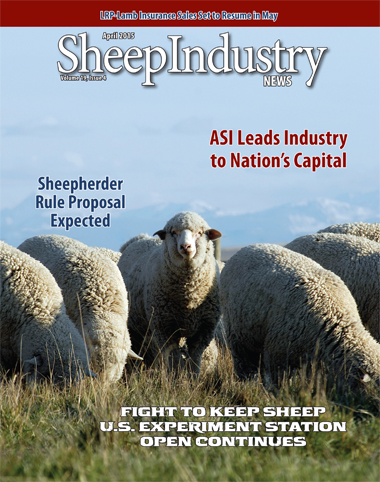
- April 2015
- President’s Notes
- ASI Takes Sheep Issues to D.C.
- ‘Let’s Grow’ Points to South Dakota Success
- Fight to Keep Sheep Station Open Continues
- Workshop Provides Insight to Fall Lambing
- ASI Joins Request to Fund Animal Sciences
- LRP-Lamb Expected to Be Made Available in May
- Market Report
- Nominations for Lamb Board Due May 1
- Sheepherder rule proposals are expected
- U.S. Forest Service Risk Assessment Study Could Borrow From Wyoming’s Sheep Plan
- News Briefs
- Classifieds April 2015
Workshop Provides Insight to Fall Lambing
Sheep ranchers contemplating adding a fall lambing season to their operations could realize some real advantages, but they should weigh those against disadvantages before moving forward.
Reid Redden, North Dakota State University Extension sheep specialist, and Christopher Schauer, director and animal scientist at the Hettinger Research Extension Center (HREC), conducted a workshop at the Carrington Research Extension Center on March 11. Information was provided on establishing a fall lambing program in addition to the normal winter lambing season.
The HREC, Schauer noted, has 20 years of experience with a fall lambing program, and it has worked out quite well there. In fact, they have established a third lambing time in May as a result of this program.
Schauer listed several advantages of adding a fall lambing program to a flock. Among the advantages are the possibility of utilizing the forage produced on the operation better and the fact the weather during a fall lambing season is better than in winter. Other advantages include the following: fall lambs never go to pasture and thus there are fewer parasite problems; generally those lambs will catch the higher feeder lamb prices in February and March; and finally, a producer will be able to produce more lambs on a fixed facility, since the lambing shed will be used twice in a year rather than just once.
Schauer noted there are also disadvantages to consider, including the following: lower conception rates when compared to fall breeding (maybe as high as 5 to 10 percent); lower lambing percentage when compared to winter lambing (10 to 20 percent); and increased labor needs for lambing twice a year.
After weighing the various pros and cons, if a producer does decide to add a fall lambing program to his herd, Redden and Schauer outlined a program that will eventually lead to that additional lambing program.
Since the breeding cycles of both ewes and rams are pretty much seasonal, Redden outlined what determines the breeding cycle for sheep.
“The biggest factor that impacts out of season breeding is season and more specifically light,” Redden said. “The amount of daylight is what controls the majority of the seasonality of breeding.”
The two important dates to remember, he noted, are Dec. 20 and June 20 – the shortest and longest days of the year. It isn’t as much those specific days, but rather when the days start changing in length. If the days are getting longer the ewes are going to go into anestrus and when the days start getting noticeably shorter is when the ewes start cycling again. The same can be said for encouraging the rams to become active in the breeding cycle again.
“For sheep you need days of increasing daylight, followed by days of decreasing daylight to get them to cycle,” Redden explained.
The next biggest factor in getting the ewes to cycle is the ram effect, he noted. The action of rams introduced in a pen of anestrus ewes will get them to ovulate. Often it is a silent heat, but it will kick start the system and in three weeks they will cycle again.
He also noted some breeds of sheep are more likely to break the strong seasonal pattern and are more receptive to adopting a breeding cycle not so highly determined by seasons.
The HREC has seen success by attempting to breed ewes to lamb in the fall. At first there was only limited success with getting ewes to lamb at that time of the year. However, as they continued the program, they only placed ewes and rams that were born during the fall lambing season back into the fall lambing flock, since being born at that time seems to enhance the chances of those individual animals continuing with that breeding cycle.
In addition to this natural process, Redden outlined how the use of certain hormones, such as prostaglandins and gonadotropins, can also help ewes become bred out of their normal cycling times.

